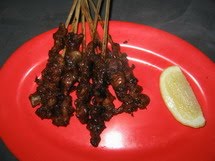Sunday, March 30, 2008
Saturday, March 29, 2008
A Thought: THE MATRIX & BUDDHISM

World Dimension
In The Matrix: they are struggling in the real world, riding a hovercraft ship observing all things that happened in the “programmed” world, called as the matrix. They have transporters to move them from the ship to the matrix; and the other way round, from the matrix to their ship using particular portals such as public phones and any other hard line.
In Buddhism: Buddhism believes in Karma. Depending on the karma, after one death, a creature can be born in any of these 31 (4+1+26) dimensions: hells (there are 4 different hells), 1 universe (our universe, but not necessarily in one place, could be in separate planet in any galaxy; earth is only one out of many other places), and heavens (there are 26 different heavens). Just like in The Matrix, a creature can also “move” from one dimension to any others and returns back again to the initial dimension. This concept in Buddhism is known as karma and punarbhava, a continuous birth and rebirth from one realm to any others before reaching Nirvana, the highest state of eternal happiness where the wheel of rebirth has been stopped.
I remember a short story told by my spiritual teacher:
A couple of husband and wife lived in heaven. One day the husband went out to pick some fruit. But then, he accidentally fell down from the tree, dropped off from heaven to earth. He’s born as a human baby, becoming adult, getting married, having children, getting old and eventually died. He then was born again in heaven, the same heaven as his previous place. His wife suddenly came and asked him, “Where have you been this whole morning? ... I thought you were picking some fruit!”***
I guess the story may give you a clearer idea, right? …that we all also live inside the “matrix”. But of course, we would not be able to move at anytime from one world to any other dimensions like in the movie using transporters and portals.
The rule of life
The matrix is created by the “Architect”. Within the matrix, all evil creatures like vampires, werewolves, ghosts, and demons are the form of system anomalies which are ruled by a programmer called the Merovingian. It is the Oracle the one who guides humans to free from the attachment of the matrix.
In Buddhism, the primary concept of Buddhism is “Life is suffering”. Since the 1st time a human is born, he/she will struggle with his/her craving (tanha), the main cause of all physical and mental suffering. Consequently, controlling our self from such desire leads only to 2 things: good or bad motivation/action. You have good motivation, you are making a good karma; bad motivation bad karma! That’s why where we lead our life depends on our self. It’s we are the one who have power to control our self.
To illustrate: when you lose a competition, you should congratulate the winner and say “I’m happy for you, I will put my effort to improve my self, so wait for me in the next competition”. This is a good thing, good motivation, hence a good karma. However, if you can’t accept this condition for not becoming the first, the winner, the best; you even talk some nasty swearing and do destructive action due to jealousy, you are accumulating your bad karma!
Furthermore, each of us is the “Architect” of our own life. We plan, control, decide what we WANT to do in living our life. Of course, in this process of living, there will be good things (as what our “Oracle” guides and advises us to do) and also bad things (as characteristics programmed by the Merovingian that leads to our own upheaval). Finally, it takes our hard effort to control our self, to free us from any attachment, to liberate us from suffering. Peace!
Acknowledgement: Diyono Puji Harjoko (Pak Puji)
Posted by
Surya
at
10:15 PM
2
comments
![]()
Labels: literature, sharing opinion
Sunday, March 23, 2008
Bubur Candil
Prepare:
- sweet potatoes (steamed till soft then pealed), u can use either purple or yellow sweet potatoes or mixed between them
- tapioca flour
- palm sugar and white sugar
- pandan leaves (2 pieces)




Rounding dough into small balls
Mashed already steamed and pealed sweet potatoes, add tapioca flour little by little, mix it by hand till the dough seems to be saturated with flour. You can add some more water to enable mixing more tapioca flour. The more tapioca flour you put, the chewier the texture will be (as some people prefer chewable texture).
Take the dough into small pieces and round them tightly into small balls.
Preparing palm sugar brown syrup
On the half way making the balls, you can prepare the brown syrup.
Estimate that the amount of water used is enough to soak the whole balls. Boil water, put 2 pieces of pandan leaves, couple pieces of palm sugar (just enough to make the syrup brown). Add some more white sugar to make it sweet enough for you. Turn off fire when all sugar has been dissolved and the syrup gets boiled. Strain it.
Note: you can add some more dissolved tapioca flour (± 2 spoonful tapioca flour dissolved with water first) when cooking the syrup to make it thick (It’s supposed to be very thick)
Boiling the ball dough
Using other pan, boil water (make sure it’s enough to boil whole dough balls). You can put in the balls only when water has been boiled.
Once the balls floated, lift the balls, and immediately put them in the already cooked syrup.
Preparing coconut milk
Grate coconut, soak in hot water, and squeeze it.
Boil the milk with medium heat, put 1 piece of pandan leaf, and add couple pinches of salt.
Note: You can also use fresh milk with a pinch of salt instead of coconut milk. My mum and I prefer using fresh milk.
Suggestion: put this candil in the fridge. Eat cold is better as a dessert. Just spoon out the candil in a small bowl, pour coconut milk or fresh milk. And…Bon Appétit!!!
Thanks to Iko Indrayana of TPPI Lab. Tech. for the recipe.
Posted by
Surya
at
8:22 PM
2
comments
![]()
Labels: food-cooking-recipes
Saturday, March 22, 2008
Condiment for Vietnamese Spring Roll
 Vietnamese spring roll is easy to prepare. I would recommend to serve this dish during gathering, spending weekend among close friends, chit chat, well...making spring roll together, the more people the merrier it will be!
Vietnamese spring roll is easy to prepare. I would recommend to serve this dish during gathering, spending weekend among close friends, chit chat, well...making spring roll together, the more people the merrier it will be! Basically, you need rice paper. Soak the rice paper in hot (not warm) water for couple second then you’re ready to wrap your own spring roll. You can combine your filling with anything you like: Sliced cabbage, carrot, fresh mushroom, alfalfa, meat, banana, avocado, coriander leaves, mint leaves, or boiled glass noodle.
Basically, you need rice paper. Soak the rice paper in hot (not warm) water for couple second then you’re ready to wrap your own spring roll. You can combine your filling with anything you like: Sliced cabbage, carrot, fresh mushroom, alfalfa, meat, banana, avocado, coriander leaves, mint leaves, or boiled glass noodle. Prepare in a bowl:
Prepare in a bowl:- a small can of pineapple, sliced into small pieces, use also the juice
- 5 bulbs garlic, chopped coarse
- 3 bird’s eye chilies, sliced thin (dump the seeds)
- 2 small tomatoes, sliced into pineapple size
- freshly squeezed lemon juice
- fish sauce / squid sauce (don’t put too much, you have to taste whether or not it is salty enough)
- a little bit sugar (optional) for sweetener, if not sweet enough

Thanks to Mbak Mariaty - Townsville, Qld
Posted by
Surya
at
11:25 PM
0
comments
![]()
Labels: food-cooking-recipes
Thai Salad, for coriander lovers
Try Thai Salad for fresh oriental taste. Mix following ingredients:
1. glass noodle / rice vermicelli (soak in hot water for a moment)
2. boiled shrimp (as many as you want)
3. coriander leaves (as many as you want)
4. fresh shallot (cut thick)
5. lemon grass (sliced fine)
6. fish sauce (you can also add some salt)
7. freshly squeezed lemon juice
8. white pepper powder
9. fried shallot

***** easy to prepare for gathering
***** unique oriental taste
Thanks to Icha for introducing this marvelous taste
Posted by
Surya
at
11:11 PM
0
comments
![]()
Labels: food-cooking-recipes
Sambal terasi gw

Prepare:
1. bird’s eye chili, you can use 8 up to 13 chilies; sliced thin for ease when grounding
2. one bulb of garlic, for taste and aroma sharpener. Do not put more than 1 garlic bulb as it will spoil the taste!
3. about 2/3 to 1 teaspoon of terasi or shrimp paste
4. about 1/2 to 2/3 teaspoon of salt
5. lime leaves, 2 pieces, sliced thin for ease when grounding
!!! Just take a look at the picture for the proportion of ingredient I use!!!

Put the whole ingredient in a mortar and ground them well!
NOTE: ground the whole ingredient including chili seeds till becoming the smooth paste. Do NOT use blender!!! Or the taste will be different, not as punchy as the manually grounded one.
Posted by
Surya
at
10:07 PM
0
comments
![]()
Labels: food-cooking-recipes
Thursday, March 20, 2008
Beggar in Indonesia, a profession?
What I had experienced recently really reminds me on what my friend had told me about beggars’ life in Indonesia...
It was about 9 a.m. I was in a small warung (small shop that sells daily needs) in Tuban waiting for the bus to Semarang. Sitting in the corner of the warung, was an old lady wearing dirty clothes. The first bus from Surabaya just arrived and stopped by a restaurant, next to the warung, for the passengers’ meals. The old lady quickly took a position, sitting on the ground near to the restaurant entrance, begging for money to anyone passing in front of her.
From the warung owner, I got information about this lady. She said that this lady lives quite far from the restaurant, definitely not a walking distance for an old lady. She has to spend about Rp. 3000.00 (US$ 0.3) for the transportation fee to get into this place (in front of the warung) every day just before 9 a.m.
Before going home, the old lady always sits in front of her warung to count the amount of money she has collected. That’s why the warung owner knows that she can get at least Rp. 75.000.00 to 80.000.00 per day. Sometimes she could earn up to Rp. 150.000.00 per day.
Big amount of money!!! said the warung owner with heavy tone to me. I can understand her tonal expression of dissatisfaction. The warung owner who’s also an old granny said that even running a warung selling sugar, rice, soap, and other stuff, she rarely can reach such amount of net margin within a day compared to the beggar who does nothing except sitting and waiting patiently begging people for money!!!
Surprising!? Let’s play a simple math, say the beggar earns Rp. 50.000.00 per day. That equals to Rp. 1.500.000.00 per month, an amount which is even more than the standard salary of fresh bachelor graduate in most places in Indonesia!!!
While waiting all passengers going back to the bus, I saw the first young guy gave the old begging lady Rp. 3000.00. Well, that’s already enough to cover her transportation fee. And that’s just from one person, from the 1st bus. The bus comes every 1.5 hour in average from 9 a.m. till 2 a.m. next morning. So, I guess, she can go back home anytime she wants from her “work place”. A home with 4 bedrooms and a proper family bathroom, described by the warung owner as she had visited her before. Doesn’t sound like a beggar’s property, huh?
This is only one example of a beggar’s life in Indonesia. Well, I’m sure that most of them are struggling to live their life and have no other choice to desperately become a beggar because of the situation that makes them to. However, some of them seem to have been enjoying that living as a beggar is a kind of an “easy-money-making profession” which requires an “art” behind that.
The art of acting! Yes, they have to act with a sorrowful expression when begging people. Bandage the healthy legs and pour some yellowy fermented liquid on it so then lots of flies attached in, try to make an impression of a guy with terrible illness that he can’t afford to cure it, hence expecting people’s sympathy and of course, charity! (Rahmawan, 2001)
Very often they exploit little kiddies, let them beg under the traffic light. The middle-aged women rent or borrow the baby of their group, intentionally let the baby cry loudly, and then they beg for money asking donation to buy milk and food for their “poor baby”. This art of begging can be performed in any public place, along the road, city corner, pavement, in front of shopping malls, under traffic lights, and other busy places.
Talking about exploitation, they even exploit themselves. I know that most beggars are handicapped, blind, or having other physical disabilities. However, they tend to dramatize their disabilities to draw people’s sympathy. I don’t know whether such thing can be considered as a self exploitation, or should I consider it, again, as the art of begging. One real example I’ve experienced was with a guy who has eyes disability, thus wearing black glasses, begging for money on the train. A donation box he brought was in his left hand and a stick for guiding him was in another hand; passing slowly behind a standing woman. He intentionally almost-dropped his body towards the woman, pretending that he hadn’t enough strength like other “non-disability” people had to restrain the train shaking. It looked really awkward to see his exaggerated action just to respond the constant train shaking. The woman just helped to stabilize him. I really noticed that he deliberately did that. I knew that! I had been noticing his behaviour, since he entered our compartment.
My friend who did a social study about street boys and beggars has visited their home. What he found was quite surprising him: a set of VCD player and TV in a comfortable living room, cell-phone...totally beyond his expectation!
Once, my friend saw a guy with a nasty appearance begging in a train station. Another occasion, he noticed the same guy, but with a proper shirt talking on his cell-phone in another train station!
From all points above, it seems that being a beggar in Indonesia appears to be the last easiest solution to make money. Lots of people from remote area, who are stimulated with the glamour of metropolitan life, come to the big city expecting to get a good job, good money, without well preparation or without being equipped with any skill to get a job. Eventually, they desperately start begging people. Very soon, they will discover the art of begging to earn enough money; just like the old lady I saw next to the restaurant. So, the art of begging = technique to make money? The higher the art of begging they can master, to more money they can collect, I suppose.
But, would that be a good future for a developing country like Indonesia? Would this lead to an effortless Indonesian generation that do thing without careful thinking or preparation? Or can “beggar” be considered as a title of a profession? What and where’s the best way to donate our money then? How can we trust that the institution doesn’t corrupt our donation?
Hmmm. Another never-ending chaotic social problem in Indonesia to discuss. May everyone be well and happy. –S–
Posted by
Surya
at
8:36 PM
0
comments
![]()
Labels: day by day, human behaviour, sharing opinion
Tuesday, March 18, 2008
Tuesday, March 11, 2008
Trips and Food Safari: Salatiga




Salatiga is a pleasant little town, located in the middle part of Java, about 1.5 hours drive heading south from Semarang, the capital city of Jawa Tengah. This place is surrounded by two volcanoes, Mt. Merbabu and Mt. Telomoyo. The highland Salatiga has cool climate which makes it so comfortable for a relaxing holiday.
If you take a drive to Kopeng, somewhere along the way, you'll find a place to eat called "Fani". This place is quite popular because they serve only satay and rica-rica, a traditional Manado culinary, using unusual meats: porcupine, civet, wild cat, or dog!




We went there to taste those unusual meats. I didn't mind to taste them, but not for the dog meat. I was thinking to try squirrel meat and one of those wild cats. Unfortunally at that time, they only had porcupine and dog meat available. They said that this depends on what the hunters caught. Porcupine, I think, was the most common animal found around the mountain in Salatiga as they were always available on the menu.
So, we just ordered porcupine satay and porcupine rica-rica. Porcupine meat had hard texture and specific smell. Well, it was quite tiring to chew this rubbery meat. I think, that would be my first and last time to eat porcupine.


Other things that you can try when visiting Salatiga are: Nasi koyor, the traditional mixed rice with beef and coconut milk sauce; tingting gepuk or grounded peanut candy; and beef abon or herbs-flavoured roasted beef.
Posted by
Surya
at
7:48 PM
2
comments
![]()
Labels: food-cooking-recipes, trips and travelling




























